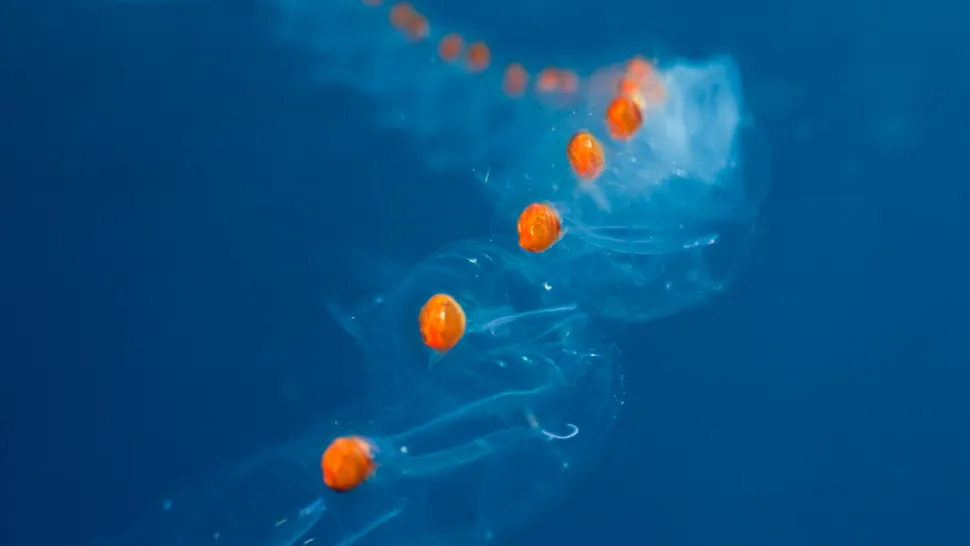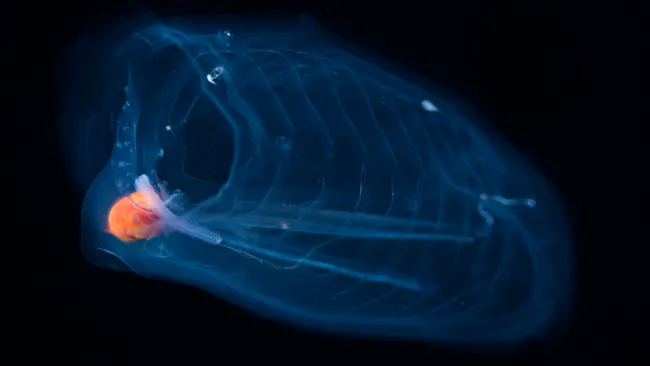In just 48 hours, salps can reach maturity, making them the fastest-growing multicellular animals on Earth, with a significant impact on ocean health.
Name: Salps (Salpa fusiformis)
Habitat: Salps are widely distributed across both the Pacific and Atlantic Oceans.
Diet: They feed primarily on phytoplankton and anything small enough to be captured by their feeding nets.
Why They’re Fascinating: Often likened to “jelly balls” or “buckets of snot,” these intriguing marine creatures are transparent with a gelatinous texture. Salps are part of a larger family, with over 70 species globally, though Salpa fusiformis is the most prevalent. They inhabit depths ranging from the ocean’s surface to about 2,600 feet (800 meters).
Salps exhibit a unique barrel shape, growing from a mere 0.08 inches (0.2 centimeters) at birth to a maximum of around 4 inches (10 cm) in adulthood. They have the fascinating ability to form long, drifting chains that follow ocean currents. In addition to their drifting lifestyle, salps are adept swimmers, using jet propulsion to navigate through the water. They achieve this by pumping seawater through their bodies using muscular bands. As water is expelled from their rear, food is filtered and the salp is propelled forward, earning them a spot among the fascinating “sea squirts.”

Name: Salps (Salpa fusiformis)
Habitat: Salps are found throughout the Pacific and Atlantic Oceans, from the surface to depths of around 2,600 feet (800 meters).
Diet: These gelatinous marine creatures primarily consume phytoplankton but filter a wide range of particles using their internal sticky mucus nets.
Why They’re Fascinating: Unlike jellyfish, salps lack stinging cells, making them harmless to touch. They are often described as “jelly balls” or “buckets of snot” due to their transparent, gelatinous appearance. There are over 70 species of salps worldwide, with Salpa fusiformis being the most common.
Salps play a vital role in mitigating climate change. By filtering vast amounts of water, a swarm covering 38,000 square miles (100,000 square kilometers) can capture up to 4,000 tons of CO2 in a single night.
Life Cycle: Salps exhibit a remarkable life cycle with two distinct phases: an asexual oozoid phase and a sexual blastozooid phase. During the oozoid phase, they produce long chains of identical clones. These chains then transition into sexually reproducing blastozooids. Initially, the chain consists entirely of females, which produce eggs fertilized by male blastozooids. The eggs develop internally, and the salps give birth to live young that mature into asexual oozoids. Eventually, the entire chain shifts to males, releasing sperm to fertilize the eggs of female blastozooids.
Remarkable Growth: Salps are among the fastest-growing multicellular animals, maturing in just 48 hours. They can increase their body length by up to 10% per hour, showcasing one of the quickest growth rates in the animal kingdom.
